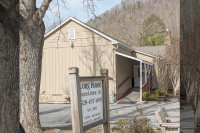Taking readers to a warm and colorful place
As cooler weather plucks leaves from the trees, stripping the branches bare as a freshly-barbered poodle, as that wonderful green grass of summer now takes on a sheen of frost at dawn, as fall in the mountains deepens into the icy winds of winter, many summer visitors in these parts close up their houses and head south to a place where the sun still produces heat as well as light and where a cold snap means accidentally leaving the air-conditioning on high on a mild night.
By necessity or choice, most of us stay here, hunker down, and endure the mountain winters. Some Artic souls even take pleasure in the cold rains of November, the cannonades of icy wind that mark December, the gray skies and slick roads of January. But shivering alongside them are those sun-worshippers who would in a heartbeat fly like a bat out of a snowstorm to be warm again, to be oppressed by heat and humidity, to lie on a beach beneath a hot sun and melt into the white sand like an ice cube in a frying pan.
These are the people who, lacking the funds to take themselves permanently off to latitudes closer to the equator, will either spend the next few months shivering forlornly in their sweaters and blankets or else use their imagination to draw the heat and the sunshine to them.
For those cold readers looking for a touch of warmth, they might try taking up in their frozen fingers James Lee Burke’s latest novel, The Glass Rainbow (ISBN 978-1-4391-2828-9, $25.99). Set in New Iberia, La., in the summertime, The Glass Rainbow throws off a steamy heat that should warm the hearts of all who love suspense and mystery in their fiction.
Dave Robicheaux, the New Orleans detective created long ago in the novel The Neon Rain, has aged in this latest story, but he still works for the New Iberia Police Department, fights the pull toward drinking a bottle of Beam to squelch his nightmares about by Vietnam and his police work, and fights the good fight for decency against a low-life, grubby world.
In The Glass Rainbow, Robicheaux and his best friend and former partner, Clete Purcel, set out to solve the murder of some young girls, including Bernadette Latiolais, a high school honor student snatched and killed while walking home from classes. In their quest for justice, the two men run across the same sort of lowlifes and scum encountered in previous Robicheaux novels.
Related Items
They must fight against a best-selling author who is also a con-man and a killer; a descendent of the wealthy planter class, also a novelist, who has lured Alafair, Robicheaux’s daughter, into his circle of wealth and prestige; a pimp and drug dealer named Herman Stinga, who seems to enjoy himself most when he is irritating people; and a full company of other characters who seem to occupy nearly every point on anyone’s moral compass.
Though Dave Robicheaux figures prominently in The Glass Rainbow and the other books and has successfully battled the demons of his life — he is married to a beautiful, understanding woman, has raised a daughter, and lives in an idyllic Louisiana glade — it is Clete Purcel, Robicheaux’s partner, who most compellingly attracts our attention. Unlike Robicheaux, Purcel hasn’t come to terms with the torments of his past: he smokes too much, helps keep several liquor stores running a profit, runs around with women, and has a temper like a volcano. Early in the book, Robicheaux says that “Clete was the libidinous trickster of folklore, the elephantine buffoon, the bane of the Mob and all misogynists and child molesters, the brain-scorched jarhead who talked with a dead mamasan on his fire escape….” Robicheaux knocks at the door; Purcel kicks it off the hinges.
What sets Burke’s novels apart from others in the genre of suspense, however, is his description of Louisiana weather and landscape, descriptions so vivid that readers can soak up the heat of the Deep South from every page. Here, for example, is Burke’s description of a murder scene:
“We drove down the same levee where Layton had parked the pickup truck on the last day of his life. The water was high from the rain, lapping across the cypress knees, the strings of early hyacinths rolling in the waves. The sky was overcast, the wind steady out of the south, and in the distance I could see a flat bronze-colored bay starting to cap and moss straightening on a line of dead cypress trees.”
Such descriptions, repeated throughout the book and so planting a believable background to the story, open for us the door to Robicheaux’s world and allow us to step into his life and walk beside him. They carry us out of ourselves and our daily lives. Burke paints these landscapes with such bright and powerful colors and lines that they may help even a shivering reader remember that the whole world isn’t a winter wasteland of gunmetal skies, brown grass, and bare trees.
The Glass Rainbow by James Lee Burke. Simon & Schuster, 2010. 448 pages









